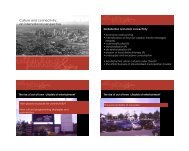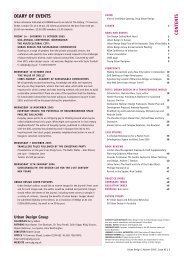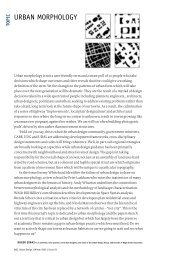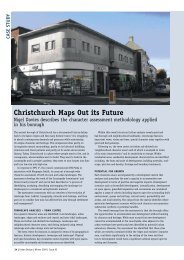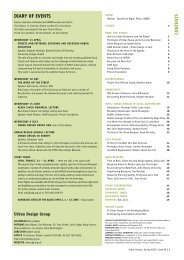topic - urban-design-group.org.uk
topic - urban-design-group.org.uk
topic - urban-design-group.org.uk
Create successful ePaper yourself
Turn your PDF publications into a flip-book with our unique Google optimized e-Paper software.
TOPIC<br />
Above ‘Expo’ figure ground plan Kronsberg, Hannover<br />
essential services and facilities at a neighbourhood scale – the<br />
delivery of a sustainable community. The first phase will be<br />
concerned with addressing the level of area based stigma.<br />
Initial market research on housing in the West End of the city,<br />
quickly realised that any development would have to become<br />
‘world class’ in order to address the reputation of the area. The<br />
definition of what the over-used phrase of ‘world class’ actually<br />
means in practice has led to a broad benchmarking exercise in<br />
international housing expos and the production of a business<br />
case for a NExpo (a North East expo based on the postcodes from<br />
the pathfinder area).<br />
The idea of a housing expo operates on several levels. It is to<br />
provide a physical legacy of a range of examples of sustainable<br />
<strong>urban</strong> development, both refurbishment and new build, that<br />
are relevant to many of the northern cities; and to develop a<br />
marketing and promotion strategy (that includes short-term<br />
exhibition and promotional material) to address some of the<br />
social attitudes to living in the inner-city area and perhaps of<br />
particular sustainable housing types.<br />
SUSTAINABLE HOUSING PROJECT<br />
There are many smaller sites throughout the pathfinder area<br />
that are more typically <strong>urban</strong> ‘brownfield’ infill, where there are<br />
challenges to provide a locally complementary housing mix and<br />
additional choice, specifically a market for sustainable housing<br />
options.<br />
The city council is incorporating and encouraging sustainable<br />
<strong>design</strong> principles into a series of statutory planning briefs<br />
that are being applied to several of these public sector owned<br />
brownfield sites throughout key regeneration sites in the city’s<br />
pathfinder area. As there are limitations to what the planning<br />
system can provide on its own, these same principles are being<br />
used, this time on a mandatory basis, for the land owner’s brief<br />
within Newcastle City adopting principles for carbon neutral<br />
development. Each of the sites will be testing different tenure<br />
mix and a variety of housing types. All of these will aim to be<br />
constructed to ‘Passive House’ standards and using existing BRE<br />
sustainability standards. In changing the type of housing, it is<br />
inevitable that there will be a different approach required from<br />
developers that will influence and guide any approach to site<br />
marketing. Thus, the corporate approach to the commercial<br />
marketing of the development sites will be based upon a detailed<br />
analysis of the views of sustainable housing options by consumer<br />
focus <strong>group</strong>s of house buyers within the sub region and through<br />
testing with a variety of ‘bespoke’ and volume house builders.<br />
SUMMARY<br />
In the processes outlined above, there is a growing link between<br />
<strong>urban</strong> <strong>design</strong> and environmental sustainability that is explicit<br />
and directly derived from national <strong>urban</strong> and planning policies.<br />
The prevalent political confidence,<br />
that <strong>urban</strong> forms of development are<br />
inherently more sustainable and that<br />
they will become a marketing attraction<br />
for the regional housing market, is<br />
still to be proven. In a similar way, the<br />
assumption that <strong>design</strong> quality and<br />
innovation, even supported by the right<br />
type of marketing, can address locational<br />
stigma and compensate for higher<br />
density living in neighbourhoods with<br />
social problems and comparatively poor<br />
educational attainment levels may be<br />
slightly naive.<br />
The projects show how Tyneside is<br />
exploring sustainable housing options<br />
at a variety of different scales, aiming to<br />
generate a regional market for sustainable<br />
housing. In doing so, and attempting<br />
to mainstream existing sustainable<br />
technical and construction methods<br />
through a variety of delivery processes,<br />
there is a growing awareness of the<br />
importance and impact of political and<br />
socio-economic systems in the delivery<br />
of sustainable development. Often to<br />
achieve the sustainable <strong>urban</strong> option,<br />
there is the need to innovate and take<br />
risks in procurement and delivery process<br />
and not simply leave <strong>urban</strong> <strong>design</strong><br />
as a physical discipline. Ultimately,<br />
the various processes are testing the<br />
policy tensions between community<br />
involvement, with all of the challenges<br />
around capacity building and devolving<br />
decision-making, and environmental<br />
sustainability. Urban <strong>design</strong>ers need to<br />
be aware and responsive to these broader<br />
social and political concerns.<br />
Yet there is a danger that rather than<br />
aiming for the type of <strong>urban</strong> restructuring<br />
set out in the sustainable communities<br />
plan, where social mix is achieved<br />
through a variety of housing types, sizes<br />
and tenures that commercially safer<br />
options are pursued.<br />
If the pathfinder programme is<br />
unwilling to take risks and test the market<br />
potential for different forms of <strong>urban</strong><br />
living, it may simply become another<br />
regeneration funding stream supported by<br />
sub-regional quangos. The test will be if<br />
the measures of success of the programme<br />
on Tyneside are qualitative, not simply<br />
empirically driven outputs based on<br />
the number of housing demolitions,<br />
completions and the audited approach to<br />
the use of public finances. At the moment<br />
the rhetoric and principles are sound, and<br />
there are several examples of innovation<br />
in <strong>design</strong> processes, but the priorities<br />
have yet to become consistently evident<br />
through the use of the extensive public<br />
resources available to the programme.<br />
Michael Crilly is Senior Urban Designer with<br />
Newcastle City Council. The views expressed in this<br />
article do not necessarily reflect those of Newcastle<br />
City Council.<br />
28 | Urban Design | Autumn 2004 | Issue 92



